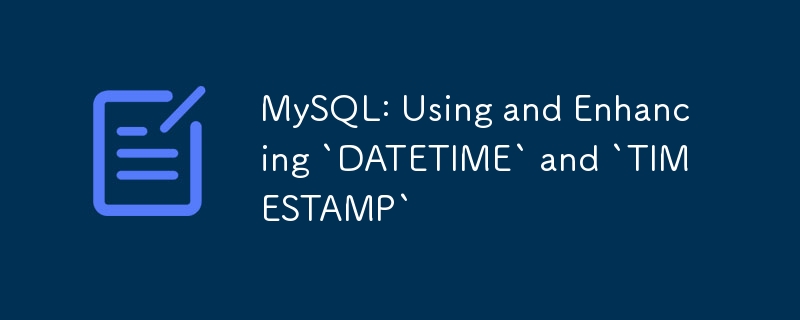Home >Database >Mysql Tutorial >MySQL: Using and Enhancing `DATETIME` and `TIMESTAMP`
MySQL: Using and Enhancing `DATETIME` and `TIMESTAMP`
- 王林Original
- 2024-07-19 12:40:08824browse

Introduction
In MySQL, DATETIME and TIMESTAMP are commonly used data types for storing temporal values. Although both serve the purpose of storing date and time, there are fundamental differences between them that affect their usage. This article will explore the differences between DATETIME and TIMESTAMP, and how to overcome some limitations of DATETIME to leverage the advantages of TIMESTAMP.
Differences Between DATETIME and TIMESTAMP
Range:
- DATETIME: Can store values from '1000-01-01 00:00:00' to '9999-12-31 23:59:59'.
- TIMESTAMP: Can store values from '1970-01-01 00:00:01' to '2038-01-19 03:14:07'.
Storage:
- DATETIME: Stored as is, in date and time format, without relying on the time zone. It requires 8 bytes of storage.
- TIMESTAMP: Stored as an integer representing the number of seconds since 1970-01-01 00:00:00 UTC. It requires 4 bytes of storage.
Time Zone:
- DATETIME: Does not depend on the time zone and stores the value as is.
- TIMESTAMP: Affected by the current time zone of the MySQL server. When inserting or retrieving values, they are automatically converted between the local time and UTC.
Automatic Updates:
- DATETIME: Does not support automatic updates directly when a row is modified.
- TIMESTAMP: Can be set to automatically update the value when a row is modified using the options DEFAULT CURRENT_TIMESTAMP and ON UPDATE CURRENT_TIMESTAMP.
Enhancing DATETIME Usage
To overcome some limitations of the DATETIME data type, you can follow these strategies:
1. Standardizing Time Zone
To solve the issue of DATETIME not adhering to the time zone, you can standardize all temporal operations at the database and application level to use UTC.
Setting the Database to Work in UTC:
SET GLOBAL time_zone = '+00:00'; SET time_zone = '+00:00';
Converting Values to UTC on Insertion:
INSERT INTO example_table (event_time) VALUES (CONVERT_TZ('2024-06-19 12:30:00', 'Your/Timezone', '+00:00'));
Converting Values from UTC to Local Time on Retrieval:
SELECT CONVERT_TZ(event_time, '+00:00', 'Your/Timezone') as local_event_time FROM example_table;
2. Automatic Updates
To automatically update DATETIME values when a row is modified, you can use triggers.
Creating a Trigger to Update the Field on Modification:
CREATE TRIGGER before_update_example_table BEFORE UPDATE ON example_table FOR EACH ROW BEGIN SET NEW.updated_at = NOW(); END;
3. Using Default Values
To set DATETIME values automatically on insertion, you can assign default values using the NOW() function.
Setting Default Fields:
CREATE TABLE example_table (
id INT PRIMARY KEY AUTO_INCREMENT,
created_at DATETIME DEFAULT CURRENT_TIMESTAMP,
updated_at DATETIME DEFAULT CURRENT_TIMESTAMP ON UPDATE CURRENT_TIMESTAMP
);
4. Handling Precision
If higher precision for times is needed, you can use DATETIME(6) or TIMESTAMP(6) to store times up to microsecond precision.
Creating a Table with Microsecond Precision:
CREATE TABLE example_table (
id INT PRIMARY KEY AUTO_INCREMENT,
created_at DATETIME(6) DEFAULT CURRENT_TIMESTAMP(6),
updated_at DATETIME(6) DEFAULT CURRENT_TIMESTAMP(6) ON UPDATE CURRENT_TIMESTAMP(6)
);
5. Handling Times in the Application
Ensure your application handles times correctly by converting all times to UTC before storing them and converting them back to local time when displaying them to the user.
Example in PHP:
// Setting the application time zone to UTC
date_default_timezone_set('UTC');
// Storing the current time as UTC
$current_time_utc = date('Y-m-d H:i:s');
$query = "INSERT INTO example_table (event_time) VALUES ('$current_time_utc')";
// Retrieving the time and converting it to local time
$event_time_utc = '2024-06-19 12:30:00';
$event_time_local = new DateTime($event_time_utc, new DateTimeZone('UTC'));
$event_time_local->setTimezone(new DateTimeZone('Your/Timezone'));
echo $event_time_local->format('Y-m-d H:i:s');
Summary
- DATETIME: Used for storing dates and times without time zone dependencies. Suitable for future events or fixed scheduling.
- TIMESTAMP: Used for tracking time relative to the current time zone. Suitable for logging the time when data is inserted or updated.
Enhancing DATETIME
- Standardizing Time Zone: Use UTC to standardize times.
- Automatic Updates: Use triggers to update fields automatically.
- Default Values: Set default values for the DATETIME field.
- Precision: Use DATETIME(6) for higher precision.
- Handling Times in the Application: Correctly convert times between UTC and local time.
By following these strategies, you can leverage the benefits of TIMESTAMP while using DATETIME, making it easier to handle temporal values efficiently and effectively.
The above is the detailed content of MySQL: Using and Enhancing `DATETIME` and `TIMESTAMP`. For more information, please follow other related articles on the PHP Chinese website!

